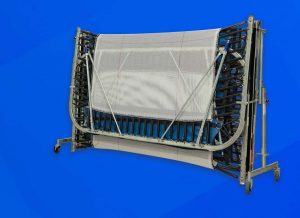More Articles...

If you want to invest in the strongest trampoline out there (one that is sure to last after your skills improve and you are not a beginner after years of experience), you’re probably unsure which one
is best for you. With different types, shapes and purposes of trampolines (i.e., competitive athletes vs. recreation) out there along with many competing trampoline brands, finding the right one is not an easy task.
Let’s start by examining the differences in shape of trampolines, and you’ll want to keep reading to find out more facts and tips.
The Difference Between Round and Rectangular Trampolines
Trampolines come in many different sizes, shapes, and price points. The reason for this is that there are many different purposes for a trampoline, ranging from person backyard fitness right up to high end athletic training for a variety of sports to include actual Competition Trampolines.
Round trampolines
This shape is common for backyard recreational trampolines. There are good reasons for that.
- Due to the circular top frame the inward force of the springs can be supported with the least frame weight, making them lighter and cheaper.
- The jumping surface is symmetrical so when jumping in the middle you are a good distance from the edges in all directions. Hence if you will not use your trampoline for somersaulting a round trampoline is a cost effective option.
- With recreational trampolines, the main source of energy loss is the air resistance of the black mesh bed. With round trampolines, the bed surface area can go up very quickly with increased bed size which will reduce power drastically.
- Some round trampolines are so light they can be blown around by strong winds.
Rectangular trampolines
All competitive trampolines have rectangular beds which are twice as long as they are wide.
- This bed shape is suitable for somersaulting activities, as mistakes are more common lengthwise.
- The bed has a lower surface area for a given length. This means more power for a given bed technology and margin for error.
- The frame shape is suitable to align the springs with the bed’s weave. This makes the bed tension more even throughout.
- The frame needs to be heavier to properly combat the inward forces of the springs. This involves added cost.
Safety
How safe a trampoline is dependent primarily on how, where and by whom it is used.
Follow Safety guidelines such as only one athlete on the trampoline at a time, appropriate height and skill level to the athlete’s ability on the day and the equipment etc. So a beginner on a small trampoline should jump low.
Larger is generally safer if all things were equal.
Be aware that cheaper models may have cheap springs which introduce higher maximum forces (a hard bottom) or might have minimal frame padding.
Purchasing from a Reputable Trampoline Brand is a good start. Please note that most online reviewers and testers cannot tell you what a product will be like 5 or 10 years later.
Usually, you get what you pay for.

